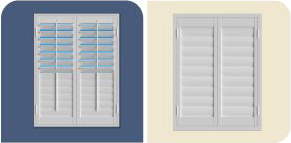
Plantation Shutter Myths Busted
Sunburst Shutters Washington has busted a few shutter myths in the past. During our last myth-debunking binge, we looked at a few common misconceptions people have about interior shutters in Seattle.
Well, the Sunburst Shutters Washington team is back to correct the record on a couple more myths we’ve been hearing from people around Washington. Let’s jump right in.
Myth #1: “Plantation Shutters Don’t Look Good In Anything Except Southern Homes.”
When some people see the phrase “plantation shutters,” they immediately go to the image of a huge, elegant southern house surrounded by plains. While it’s true that the shutters owe their name to that location and time, plantation shutters were seen commonly in homes way before and way after 19th Century Southern America.

Nevertheless, plantation shutters can give those same benefits to any home, no matter its style or location. Craftsman style houses can use shutters, just like Colonial homes, Prairie houses, and even cottage houses can.
Myth: “My Home Style Won’t Work With Shutters Is Too Eclectic For Shutters.”
Because plantation shutters have been so popular for so long, some homeowners might think that shutters might look somewhat boring. We’ve worked with a customer previously who claimed that their space was “too eclectic” for shutters, which was a tad confusing–since shutters are probably the only window treatment that can complement any style.

Myth: “Shutters And Blinds Are Pretty Much The Same Thing.”
For some reason, there seems to be some confusion over the difference between blinds and shutters. Perhaps it has to do with people confusing “slats” and “louvers,” or perhaps the similar basic shape causes it. Either way, blinds and shutters really couldn’t be further apart on the window treatment spectrum. Here’s the basic breakdown of the two.
| The difference | Blinds | Shutters |
| Are able to block out whole window134 | No | Yes |
| Structure | Dangles from cord | Solid frame attached to window frame |
| Lifespan | Will break down or deteriorate after 2-3 years. | Will usually last 20+ years. |
| Permanent or temporary? | Temporary | Permanent |
| Increases home value | No | Yes |
| Energy Efficiency | Minimal | Can block up to 50% of heat from the sun. |
| Specialty Windows | No | Can fit any specialty shape windows. |
| What are the horizontal parts called? | Slats | Louvers |
Myth #4: “All window coverings are about the same in energy efficiency.”
Like the “Blinds vs. Shutters” table above mentions, window coverings can vary by a wide margin on how much energy efficiency they offer. The structure, material, and finish will all play a huge part in how energy efficient a window treatment is.
Offering no benefits in energy efficiency is a bare window without a covering. Offering only slightly more energy efficiency are your typical retail aluminum blinds. Up a little further on the spectrum are draperies and sturdy fabric window coverings. Going further into energy efficient territory we have most wood shutters and cellular shades, built to offer UV protection and heat reduction. But dwarfing all of these other window treatments are Polywood plantation shutters, built to both reflect and block outside temperature from passing into your home.
No More Shutter Myths
If you feel like you’re swimming in an ocean of misinformation regarding window treatments, we can toss you a lifeline. Call Sunburst Shutters Washington today at 360-464-2277 to speak to one of our experts and schedule a complimentary in-home consultation to find your perfect shutter or window treatment today.


